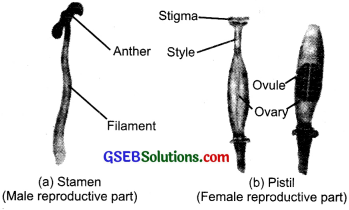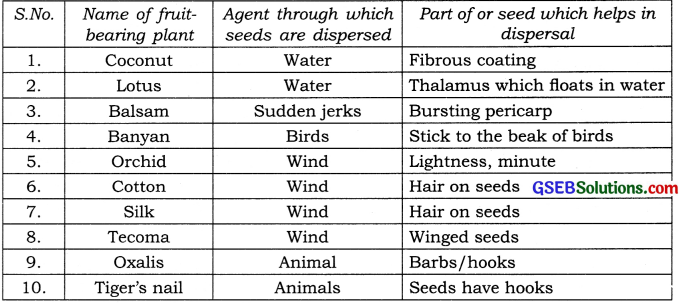Gujarat Board GSEB Textbook Solutions Class 7 Science Chapter 12 Reproduction in Plants Textbook Questions and Answers, Notes Pdf.
Gujarat Board Textbook Solutions Class 7 Science Chapter 12 Reproduction in Plants
Gujarat Board Class 7 Science Reproduction in Plants Textbook Questions and Answers
Question 1.
Fill in the blanks:
(a) Production of new individuals from the vegetative part of the parent is called ……….
(b) A flower may have either male or female reproductive parts. Such a flower is called …………
(c) The transfer of pollen grains from the anther to the stigma of the same or of another flower of the same kind is known as …………
(d) The fusion of male and female gametes is termed as …………..
(e) Seed dispersal takes place by means of and …………
Answer:
(a) vegetative reproduction
(b) unisexual flower
(c)pollination
(d) fertilization
(e) wind, water, birds
![]()
Question 2.
Describe the different methods of asexual reproduction. Give examples.
Answer:
Different methods of asexual reproduction are:
(a) Binary Fission: This process takes place in unicellular organisms. Parent cell elongates and gets divided into two identical daughter cells. Each daughter cell grows into an independent adult.
(b) Endospore Formation: In this method, the spore wall is formed around a bacterial cell to form an endospore. This endospore germinates to form an active bacterium under favourable conditions.
(c) Fragmentation: In this process, the body of the organism breaks up into two parts. Then each part grows into a new filament thus forming two organisms from a single one.
(d) Spore Formation: The spores are tiny spherical unicellular structures protected by a thick wall. The spores are stored in a hard outer covering and this is called a sporangium. Under favourable conditions, the hardcover breaks and spores spread for germination.
(e) Budding: In yeast, new organisms are produced by the bud formation from the parent organism. After growing to full size, the budgets detached and forms a new independent individual.
(f) Vegetative propagation: When vegetative parts of a plant like stems, leaves and roots, etc., give rise to new ones, it is called vegetative propagation.
![]()
Question 3.
Explain what you understand by sexual reproduction
Answer:
Sexual reproduction means the involvement of two parents in the process of reproduction. It is found mainly in higher plants where male gamete and female gamete fuse to form a zygote These zygotes develop into individuals which are not identical. Offsprings inherit the characteristics of both the parents. In sexual reproduction, both parents survive after the process of reproduction.
Question 4.
State the main difference between asexual and sexual reproduction.
Answer:
Asexual reproduction:
(a) Only one parent plant is involved.
(b) Occurs in unisexual plants.
(c) Occurs in lower plants.
(d) Reproductive organs are notpresent.
(e) In most of the methods the original parent disappears.
(f) A process like a gamete formation or fertilization is not seen.
(g) Characteristics of only one parent are inherited.
(h) No need for seeds.
Sexual reproduction:
(a) Both male and female parents are involved.
(b) Occurs in bisexual plants.
(c) Occurs in higher plants.
(d) Fully developed reproductive parts are present.
(e) Original parents remain alive after the process of reproduction.
(f) Fertilization of gametes gives rises to zygote.
(g) Characteristics of both parents are inherited.
(h) Seeds are used to get new plants from a flower.
![]()
Question 5.
Sketch the reproductive parts of a flower.
Answer:

Question 6.
Explain the difference between self-pollination and cross-pollination.
Answer:
Self-Pollination:
(a) Pollen grains are transferred to the stigma of the same flower.
(b) Occurs in bisexual plants having anther and stigma maturing at the same time.
(c) It takes place in plants like wheat, peas etc.
Cross-Pollination:
(a) Pollen grains are carried to the stigma of another flower.
(b) Occurs in bisexual flowers having anther and stigma maturing at different times.
(c) It takes place in plants like lady-finger, tomato, brinjal etc.
![]()
Question 7.
How does the process of fertilization take place in flowers?
Answer:
When the pollen grain reaches the stigma of the same species flower, it starts growing out into the pollen tube of the stigma. This tube continues to grow inside the style until it reaches the ovule. Male cells are released into the ovule for the fertilization with the female egg cell and thus the zygote is formed. After this process of fertilization, the ovary develops into fruit and ovule into seeds.
Question 8.
Describe the various ways by which seeds are dispersed.
Answer:
Following are the ways by which the seeds are dispersed:
- Some light seeds like that of madar, which are hairy, dry and small are carried away by the wind to different places.
- Spiny seeds and fruits like that of. Xanthium and Urena, stick to the clothes of passers-by and animals. These seeds are carried away by these agents to different places.
- In some plants having heavy seeds like that of coconut, water acts as the dispersing agents.
- Some seeds are dispersed when the fruits burst like, in case of balsam and castor.
![]()
Question 9.
Match items in Column I with those in Column II:
| Column I | Column II |
| (a) Bud | (i) Maple |
| (b) Eyes | (ii) Spirogyra |
| (c) Fragmentation | (iii) Yeast |
| (d) Wings | (iv) Bread mould |
| (e) Spores | (v) Potato |
| (vi) Rose |
Answer:
| Column I | Column II |
| (a) Bud | (iii) Yeast |
| (b) Eyes | (v) Potato |
| (c) Fragmentation | (ii) Spirogyra |
| (d) Wings | (i) Maple |
| (e) Spores | (iv) Bread mould |
Question 10.
Tick (e) the correct answer:
(a) The reproductive part of a plant is the
(i) leaf
(ii) stem
(iii) root
(iv) flower
(b) The process of fusion of the male and the female gametes are called
(i) fertilisation
(ii) pollination
(iii) reproduction
(iv) seed formation
(c) Mature ovary forms the
(i) seed
(ii) stamen
(iii) pistil
(iv) fruit
(d) A spore-producing plant is
(i) rose
(ii) bread mould
(iii) potato
(iv) ginger
(e) Bryophyllum can reproduce by its
(i) stem
(ii) leaves
(iii) roots
(iv) flower
Answer:
(a) (iv) flower
(b) (i) fertilisation
(c) (iv) fruit
(d) (ii) bread mould
(e) (ii) leaves
![]()
Extended Learning Activities And Projects
Question 1.
Make your own cactus garden by collecting pieces cut from different kinds of cacti. Grow the variety in one single flat container or in separate pots.
Answer:
Students make the cactus garden themselves.
Question 2.
Visit a fruit market and collect as many local fruits as possible. If many fruits are not available, you can collect tomatoes and cucumbers (these are fruits, though we use them as vegetables). Make drawings of the different fruits. Split the fruits and examine the seeds within. Look for any special characteristics in the fruits and their seeds. You can visit a library also to learn about this.
Answer:
Students collect the fruits and study the characteristics of fruits and seeds themselves.
Question 3.
Think of ten different fruit-bearing plants. Remember that many vegetables are also fruits of the plants. Discuss with your teacher, parents, farmers, fruit growers and agricultural experts (if available nearby) and find out the manner of their dispersal. Present your data in the form of a table as shown below:

Answer:

Question 4.
Suppose there is one member of a particular kind of organism in a culture dish, which doubles itself in one hour through asexual reproduction. Work out the number of members of that kind of organism which will be present in the culture dish after ten hours. Such a colony of individuals arising from one parent is called a “clone”.
Answer:
The number of organisms becomes twice the initial count in one hour through asexual reproduction. Number of organisms in
1 hour = 1 x 2 = 2
2 hours = 2 x 2 = 4
3 hours = 4 x 2 = 8
4 hours = 8 x 2 = 16
5 hours = 16 x 2 = 32
6 hours = 32 x 2 = 64
7 hours = 64 x 2 = 128
8 hours = 128 x 2 = 256
9 hours = 256 x 2 = 512
10 hours = 512 x 2 = 1024
![]()